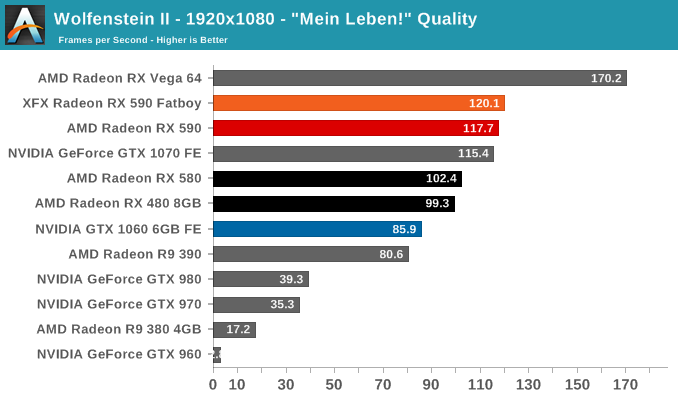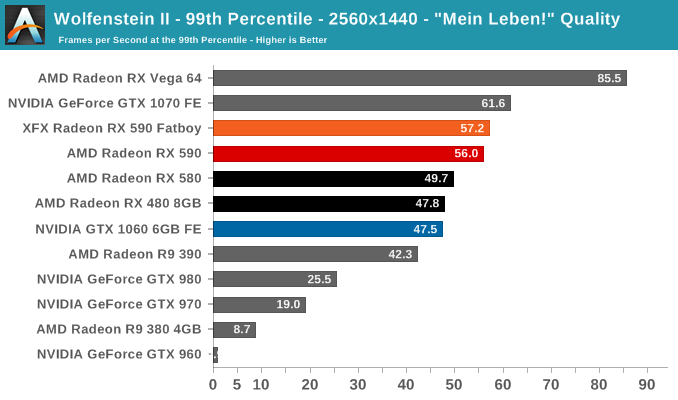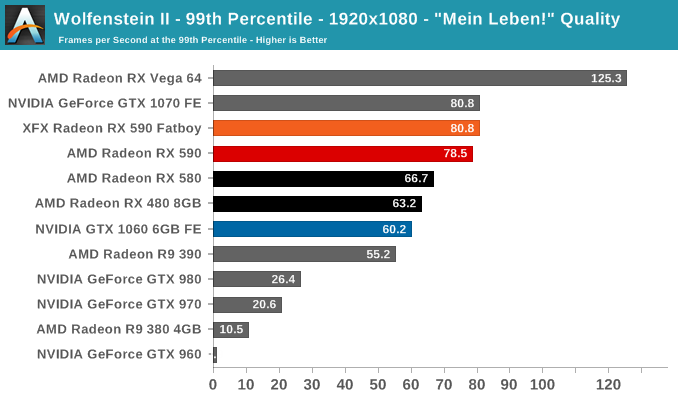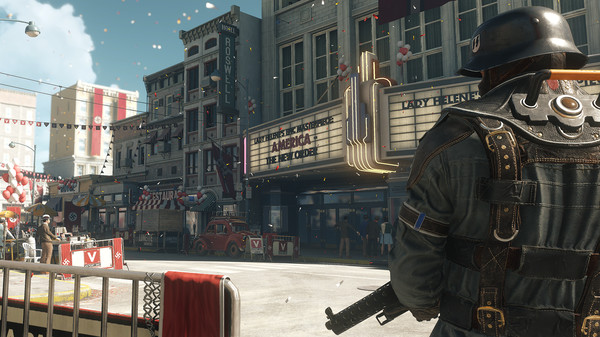The AMD Radeon RX 590 Review, feat. XFX & PowerColor: Polaris Returns (Again)
by Nate Oh on November 15, 2018 9:00 AM ESTWolfenstein II: The New Colossus (Vulkan)
id Software is popularly known for a few games involving shooting stuff until it dies, just with different 'stuff' for each one: Nazis, demons, or other players while scorning the laws of physics. Wolfenstein II is the latest of the first, the sequel of a modern reboot series developed by MachineGames and built on id Tech 6. While the tone is significantly less pulpy nowadays, the game is still a frenetic FPS at heart, succeeding DOOM as a modern Vulkan flagship title and arriving as a pure Vullkan implementation rather than the originally OpenGL DOOM.
Featuring a Nazi-occupied America of 1961, Wolfenstein II is lushly designed yet not oppressively intensive on the hardware, something that goes well with its pace of action that emerge suddenly from a level design flush with alternate historical details.
The highest quality preset, "Mein leben!", was used. Wolfenstein II also features Vega-centric GPU Culling and Rapid Packed Math, as well as Radeon-centric Deferred Rendering; in accordance with the preset, neither GPU Culling nor Deferred Rendering was enabled.


For a game that scales well and enables high framerates with minimal CPU bottleneck, Wolfenstein II has the tradeoff of needing more than 4GB at highest quality settings. This even applies to 1080p! Limited VRAM truly bottlenecks the GPU here, where a card like the enthusiast-grade GTX 980 (4GB) would typically hold its own against the mainstream-grade GTX 1060 6GB.
And so NVIDIA's historical stinginess with video memory hurts them hard here, hammering Maxwell 2 performance as only the GTX 980 Ti and above have more than 4GB of VRAM. The 2GB GTX 960 is reduced to a stuttering fit. Meanwhile, the Hawaii refresh R9 390, whose 8GB memory configuration upgrade was laughed at in 2015, has the last laugh in Wolfenstein II.
Usually, games that devour excessive VRAM have no real reason to do so other than being poor console ports. But the way Wolfenstein II runs on Vulkan has continually impressed me on many levels. It removes so much of the CPU bottleneck and truly enables usage of ultra high refresh rates at any resolution and for a bonafide AA/AAA title. The equally high 99th percentiles are perfect for VR purposes or silky-smooth 'just works' gaming, because regardless Wolfenstein II is a good-looking game. The game and engine also takes a liking to Turing, Vega, and Polaris based cards. If the VRAM consumption is not merely a correlation or coincidence, then that's a perfectly acceptable tradeoff to me.
The spare performance leaves multiple opportunities, too, and as a naive example I wonder if it'd be possible to implement something like DXR accelerated real-time raytracing at 4Kp60.













136 Comments
View All Comments
neblogai - Thursday, November 15, 2018 - link
For me, and many other people 2080 or 2080Ti might as well not exist. I'd never buy any GPU priced like that. In fact, I'd never even buy a €300+ card. Also- power use is not an issue- at 200W+, it is easy to cool, not noisy, and savings in electricity cost from having a GTX1060 would be only €5-10 per year (at 20 hour gaming per week, which I do not achieve). And in a sub-€300 market- nVidia has not offered anything for 2.5 years. So it is certainly better deal to buy a faster RX590 and get a €180 AAA game bundle for free, compared to similarly priced, slower GTX1060. There are other reasons as well, like Freesync, and futureproofing like 8GB of VRAM and better driver support (because nVidia will be moving toward doing optimizations for 20xx series).eva02langley - Thursday, November 15, 2018 - link
It is a polaris card. Everybody knew what to expect. I am not sure what you are talking about.Navi is due next year and the contender will be the 2070 RTX. I am going to speculate a tag price of 300$ which is a whole 200-300$ less than a RTX.
mapesdhs - Thursday, November 15, 2018 - link
Xex360, AMD is not trying to compete because just don't buy them, so what's the point? There market and brand awareness simply isn't there to support a high end product stack atm, not until gamers stop being so irrational and actually buy AMD when they are objectively the more sensible option, whether based on price, performance or some combination of metrics.Cooe - Thursday, November 15, 2018 - link
"but now built on GlobalFoundries' 12nm process"Sorry, Nate, but ya got that one wrong. Polaris 30 is being fabbed at TSMC, just like the rest of AMD's GPUs.
eva02langley - Thursday, November 15, 2018 - link
... sure....porcupineLTD - Thursday, November 15, 2018 - link
Where are people getting this from?Ryan Smith - Thursday, November 15, 2018 - link
Note that we currently have no information cooroborating the use of TSMC. And indeed it seems incredibly unlikely given AMD's WSA, and the fact that Polaris 30 has the exact same die size as Polaris 10. TSMC and GF's 12nm processes are not identical, porting a chip to TSMC would given you different geometry dimensions.lmcd - Friday, November 16, 2018 - link
Just like the rest of AMD's...https://www.anandtech.com/show/10446/the-amd-radeo...
GPUs. Right.
maroon1 - Thursday, November 15, 2018 - link
What a jokeOnly 12% faster but also cost and consume more power than RX580 (and 108watt more than GTX 1060 at load)
It adds noting new. It just fills the big gap between RX580 and vega56
dr.denton - Saturday, November 17, 2018 - link
"It adds noting new. It just fills the big gap between RX580 and vega56"Literally all it was ever intended to do. Polaris is a 2 year old mid range GPU design, how do you expect anything revolutionary from that?